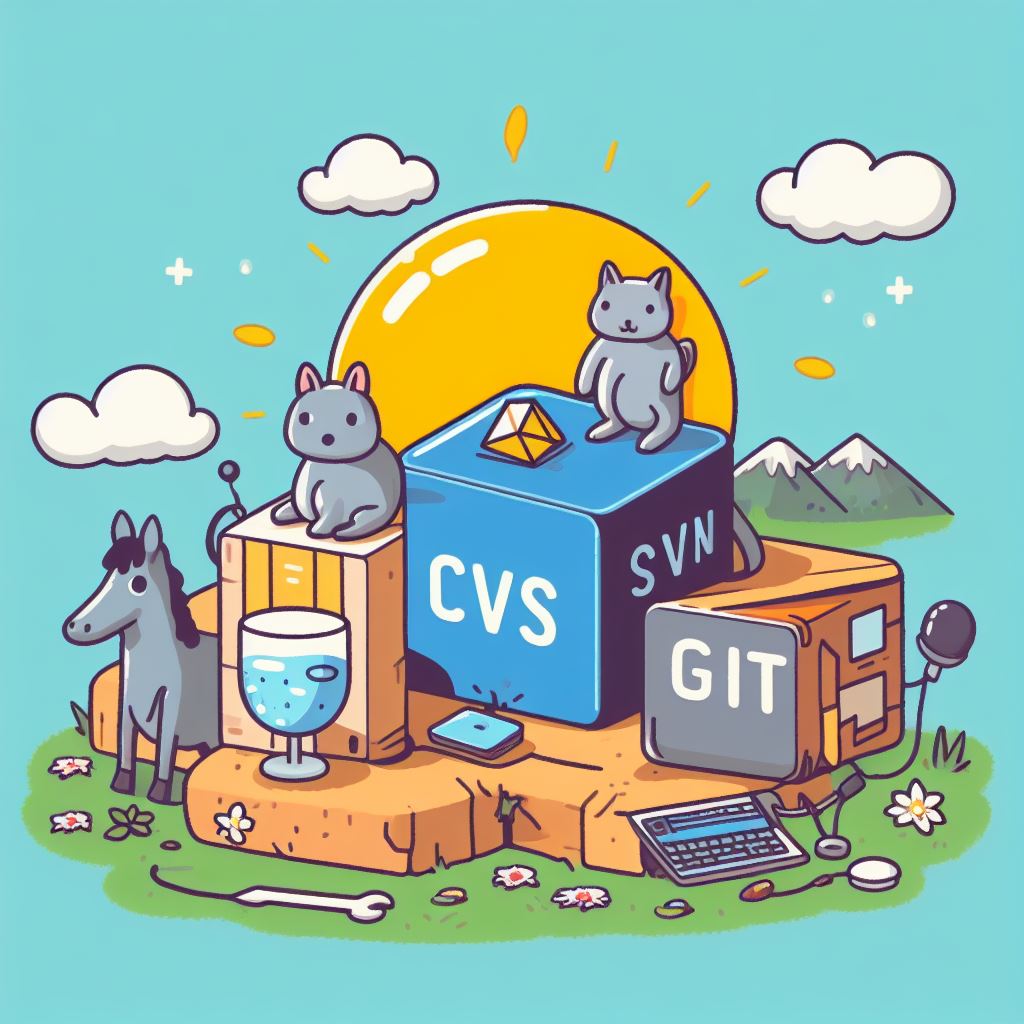In this new segment NICE FUTURE INC. will continue its dedication to improve and help people’s life, so join us as we share tips on how to make a better tomorrow.
“Anywhere,Whenever: Source Configuration Management”
What is Source Configuration Management (SCM)?
Source Configuration Management (SCM) is like a toolbox for software developers. It helps them keep track of all the changes they make to their code and other parts of their software during the development process. The goal of SCM is to keep everything organized, well-documented, and under control. This makes it easier for the team to work together and allows them to keep track of and recreate any changes made to the software over time.

Advantages of Source Configuration Management (SCM)
- Teamwork: SCM is like a team playbook. It helps everyone work together more efficiently, like a well-coordinated sports team.
- Keeping Track: It’s like a diary of the project. It records all changes made, so you can look back and see what was done and why.
- Safety Net: SCM is like a safety net. It helps prevent mistakes from causing big problems by keeping track of all changes.
- Saving Money: It’s like a budget tracker for your project. By knowing exactly what you have and what you need, you can avoid wasting money on unnecessary things.
- Quick Decisions: SCM is like a dashboard in a car. It gives managers all the important information they need at a glance, helping them make quick and informed decisions.
CVS,SVN,GIT, and Mercurial in a nutshell
- CVS (Concurrent Versions System):
- CVS is like an old-school library card system for digital files.
- It helps teams manage different versions of files, like documents and code.
- It’s not as popular today due to its limitations, but it was an early solution for version control.
- SVN (Subversion):
- SVN is like a centralized library with a checkout and return system.
- It keeps a record of all the changes made to files, making it easy to track the history of a project.
- It’s a more modern and flexible version control system compared to CVS.
- Git:
- Git is like a personal copy machine for every team member.
- It allows each person to have their own copy of a project and make changes independently.
- Git is highly popular and versatile, often used for software development and many other collaborative projects.
- Mercurial:
- Mercurial is similar to Git, but it’s known for its simplicity and ease of use.
- It’s like having personal notebooks for each team member to make changes and then sync them with the group.
- While not as widely used as Git, it’s a straightforward option for version control.
In essence, these tools are like different methods of managing projects or files. CVS and SVN are more centralized, like a shared library. Git and Mercurial, on the other hand, are like giving everyone their own copy to work on and later sync with the group. The choice between them depends on the specific needs and preferences of a team or project. Git, in particular, is highly popular for its flexibility and power.
SVN VS GIT
| Advantages | SVN (Subversion) | Git |
|---|---|---|
| Centralized Model | ✔ Centralized model provides a sense of control. | ✖ Distributed model offers flexibility. |
| Simplicity | ✔ Easier for beginners to learn and use. | ✖ Steeper learning curve. |
| Locking Mechanism | ✔ Exclusive locks can prevent conflicts. | ✖ Locks are not a standard feature, but available. |
| Mature and Stable | ✔ Established, mature, and stable system. | ✔ Rapidly evolving with a large community. |
| Speed | ✖ May be slower for certain operations. | ✔ Known for its speed. |
| Branching and Merging | ✖ Branching and merging can be more complex. | ✔ Excellent support for branching and merging. |
| Offline Work | ✖ Less suited for working offline. | ✔ Works well offline. |
| Community and Ecosystem | ✔ A strong community with resources. | ✔ Large community and extensive ecosystem. |
| Disadvantages | SVN (Subversion) | Git |
|---|---|---|
| Centralized Model | ✖ Centralized model can lead to bottlenecks. | ✖ Centralized model can lead to bottlenecks. |
| Limited Offline Work | ✖ Relies on a connection to the central server. | ✔ Supports offline work. |
| Branching and Merging | ✖ More complex and error-prone branching. | ✔ Simplifies branching and merging. |
| Complexity | ✖ Generally simpler, but limited flexibility. | ✔ Offers powerful, flexible features. |
| Learning Curve | ✖ Easier for beginners but less flexible. | ✔ Steeper learning curve with greater flexibility. |
| History Modification | ✔ Provides limited control over history. | ✔ Allows extensive history modification. |
Suitability for Project Size:
- Small Projects and Personal Projects:
- For small projects or personal projects, both SVN and Git can work, but Git is often more versatile and flexible. Git’s speed, offline work capabilities, and superior branching and merging make it well-suited for personal and small team projects. Its learning curve might be steeper, but it pays off in the long run.
- Large Group Projects:
- Git is generally the preferred choice for large group projects. Its distributed nature, efficient branching and merging, and powerful collaboration features make it highly suitable for complex and extensive group efforts. Git’s vast ecosystem and community support also make it a robust choice for large-scale projects.
While both SVN and Git can be used in various project settings, the choice between them should consider the project’s specific requirements and the preferences of the development team. Git, due to its versatility and wide adoption, is often the go-to choice for modern software development, even in larger team settings.
Github VS Gitlab

GitHub and GitLab are both web-based platforms that provide services for version control and collaboration on software development projects. While they have similar core functionalities, they also have distinct differences. Here are some key differences between GitHub and GitLab:
| Aspect | GitHub | GitLab |
|---|---|---|
| Hosting | Cloud-based, primarily hosted by GitHub (now Microsoft) | Offers both cloud-hosted and self-hosted options |
| Pricing | Free for public repositories and small teams; charges for private repositories and additional features | Free for unlimited private repositories; paid tiers for additional features |
| Integration and Ecosystem | Extensive third-party integrations and applications | Supports third-party integrations, but may not have as extensive an ecosystem |
| CI/CD | Relies on external CI/CD services like GitHub Actions | Built-in CI/CD system for automated testing and deployment |
| Security | Offers security features but might not have as extensive integration for security-related tools | Emphasizes security and offers features like container scanning, dependency scanning, and more |
| License and Open Source | Proprietary platform with a few open-source components | Open source (community edition) with options for self-hosting |
| Geo-Replication | Available as GitHub Enterprise, but comes at a higher cost | Offers geo-replication in the Enterprise Editions |
| Customization | Provides less flexibility for customization | Allows extensive customization and self-hosting |
Both GitHub and GitLab are popular and capable platforms, and the choice between them often depends on your specific needs, including hosting preferences, budget, and the level of integration and customization you require. Additionally, consider the specific features and services provided by each platform to determine which one aligns better with your development goals.
In conclusion
In the world of source configuration management, the choice between different tools and platforms can be pivotal to the success of your projects. We’ve explored the key players in this space, from Subversion (SVN) to Git, and even discussed the distinctions between two popular web-based platforms, GitHub and GitLab.
While SVN has its merits and serves as a reliable option for version control, Git’s distributed model and powerful features have earned it a special place in the hearts of developers. And when it comes to web-based platforms, GitHub and GitLab offer different advantages, with GitLab’s self-hosting option and built-in CI/CD system making it particularly appealing to those seeking more control and a streamlined workflow.
The choice ultimately depends on the unique needs of your projects, whether you’re working on personal endeavors or large group initiatives. As the saying goes, “To be continued in the next blog post…” where we will dive deeper into the intricacies of source configuration management and explore the ins and outs of GitLab as a preferred choice for vital projects within your company.
At Nice Future, we stand by your side as your trusted partner for IT solutions. Whether you’re navigating the world of version control or need assistance in any facet of your IT journey, remember that we’re here to help you every step of the way. Stay tuned for our next post, and let’s pave the way to a future full of innovation and success together.
Subscribe to our newsletter!




